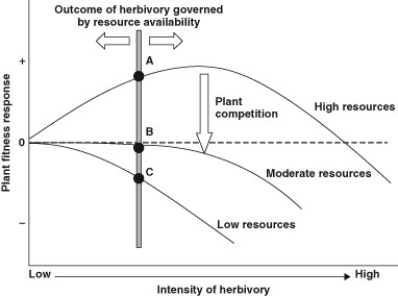Use the figure to answer the following question. The figure proposes a combination of a top-down and bottom-up model (a hypothesis) to describe the variable effects of biological control herbivores on the fitness (growth and reproduction) of an invasive, non-native plant, spotted knapweed (Centaurea stoebe) . These herbivores include multiple insects that were first studied in the plant's native home range in eastern Europe, where the plant is not dominant in grassland communities and does not pose a problem to land managers and conservationists. Many insects there were found to consume the plant's tissues, including stems, leaves, and seeds, and some were very host specific and were not found to attack plants other than C. stoebe. Several insects were subsequently transported and released in an attempt to reduce densities of this non-native and problematic weed in the United States. The y-axis shows C. stoebe plant fitness, and the x-axis represents the intensity of herbivory by the insects, from low to high. As the vertical shaded bar is moved along the x-axis, the ultimate effect of herbivory (now A, B, and C) on plant fitness can change based on its intensity and also may depend on the other factors. The horizontal dashed line represents no predicted change in fitness under the effects of varying intensity of herbivory, plant competition, and soil resources available to the plant (such as nitrogen or water) , while the three solid lines represent other possible outcomes.
The figure proposes a combination of a top-down and bottom-up model (a hypothesis) to describe the variable effects of biological control herbivores on the fitness (growth and reproduction) of an invasive, non-native plant, spotted knapweed (Centaurea stoebe) . These herbivores include multiple insects that were first studied in the plant's native home range in eastern Europe, where the plant is not dominant in grassland communities and does not pose a problem to land managers and conservationists. Many insects there were found to consume the plant's tissues, including stems, leaves, and seeds, and some were very host specific and were not found to attack plants other than C. stoebe. Several insects were subsequently transported and released in an attempt to reduce densities of this non-native and problematic weed in the United States. The y-axis shows C. stoebe plant fitness, and the x-axis represents the intensity of herbivory by the insects, from low to high. As the vertical shaded bar is moved along the x-axis, the ultimate effect of herbivory (now A, B, and C) on plant fitness can change based on its intensity and also may depend on the other factors. The horizontal dashed line represents no predicted change in fitness under the effects of varying intensity of herbivory, plant competition, and soil resources available to the plant (such as nitrogen or water) , while the three solid lines represent other possible outcomes.
(D) G. Knochel and T.R. Seastedt. 2011. Reconciling contradictory findings of herbivore impacts on spotted knapweed (Centaurea stoebe) growth and reproduction. Ecological Applications 20(7) :1903-1912.
What portion of the model would be characterized as bottom-up?
Definitions:
Classical Managerial Strategy
An approach to management emphasizing a structured, formal hierarchy and a clear division of labor to increase efficiency.
Educational Levels
The stages of formal learning, typically categorized by degrees or certificates achieved, that reflect a person's academic achievements.
Globalization
The process of interaction and integration among people, companies, and governments worldwide, often driven by international trade and investment.
Business Operations
The day-to-day activities required for a company to keep functioning and generate revenue.
Q5: Which of the following locations are major
Q8: CRM software can help salespeople plan better
Q9: Which of the following could qualify as
Q12: In testing a hypothesis that "territorial defense
Q21: Probing questions help you to uncover and
Q29: Immediately after putting on a shirt, your
Q33: Right before graduation,Roni receives two job offers.
Q34: Corneal surgery is now routinely performed to
Q48: When climbing a mountain, we can observe
Q62: Which of the following shows a brain